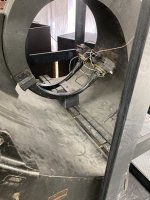The measurement he provide makes me wonder why the burst decay in his previous measurement on 65CDN-T looks so clean?
Only 8kHz shows in the previous burst decay measurement but this time there's much more.
Is that due to horn matching? Did he do smoothing on his measurement?
The other 2 drivers shows cleaner behavior on the this horn.
Only 8kHz shows in the previous burst decay measurement but this time there's much more.
Is that due to horn matching? Did he do smoothing on his measurement?
The other 2 drivers shows cleaner behavior on the this horn.
Dual CD: state of the art 1926. 😉 According to Mr. Suzuki of GIP it increases sound ‘density’. Don’t know what it means exactly but shouldn’t this produce the log10(N) or +3dB sound pressure therefore lower ‘apparent’ IMD consistent with JCrowe findings?Back to the topic. Maybe the best driver is two drivers? Just saw the new Joseph Сrowe experiments, he got very decent results with Y-Adapter dual 65CDN-T and big horn. Great measurements, no cone breakup, good low end.
This opens up the prospect of a new look at a Y-adapter, for example, with two good 1'' drivers. Of course, you need to model and print the adapter and make a horn for it (or experiment with available line array adapters and horn selection for them).
View attachment 1178971View attachment 1178978
View attachment 1178985
By the way, he also found that removing the RCF 950 back cover can have some advantages at home volume levels, which confirms my observations as well.
Attachments
I am finding integration with the horn is poor, 400-800Hz range is not full and meaty compared to a TAD 1601a.That has not been my experience. What are you wanting it to do that it does not?
Nothing new under the old sun, I know 🙂 But as with horn modeling, there are some new things in 100 years, as computer modeling and 3d printing, as well as measurement tools - perhaps this idea will get new life.Dual CD: state of the art 1926. 😉
I'm not that smart 🙂 my understanding is more surface area with less break-up effects but at the cost of more complexity of integration without artifacts.According to Mr. Suzuki of GIP it increases sound ‘density’. Don’t know what it means exactly but shouldn’t this produce the log10(N) or +3dB sound pressure therefore lower ‘apparent’ IMD consistent with JCrowe findings?
Well a bit rare not a sub!
Rob 🙂
https://www.lansingheritage.org/html/jbl/specs/home-speakers/1973-l200.htm
Used as a midwoofer in the L200, but definitely not a true midwoofer > Fs is too low, Flux Density too low, 4" VC (= too big), wrong cone shape (straight) and structure (ribbed). I'm not suggesting it's bad, but the L200's 1200Hz XO point is at least 500Hz too high.
The 2216 would work with a 2352 horn or similar crossed between 500 and 700 Hz to a 245. with Aquaplas or Be dia.
Disagree on this point, as per my previous explanation.wrong cone shape (straight)
No credible counterargument has been provided...
Yes, size is also a factor.Ro808, in addition to eff, SIZE. 😎
I'm not a fan of the snail horns > too horny for my taste, but the acoustic principles behind these dinasaurs are just as relevant now as they were then.
There seems to be tighter moderation on posting publications, but I'll see if I can find a link.Disagree on this point, as per my previous explanation.
No credible counterargument has been provided...
i am waiting for a pair a Tad 1601a so i will compare it to the JB L2216ND soon and keep the pair i will like more 😉I am finding integration with the horn is poor, 400-800Hz range is not full and meaty compared to a TAD 1601a.
Typical midwoofer (JBL EON). Don't expect deep bass in a small cab. This is of course a low-cost driver, without a high-quality magnet structure, etc.
to return to the best compression driver thread , is someone have tried the Big 18sound 4015N driver , i"m still in the search for a driver to cross near 400/500hz , other candidates are B&C DCX464 , B&C DCM50 , BMS 4592 ...
RCF ND850 seems to be a good choice too.to return to the best compression driver thread , is someone have tried the Big 18sound 4015N driver , i"m still in the search for a driver to cross near 400/500hz , other candidates are B&C DCX464 , B&C DCM50 , BMS 4592 ...
https://josephcrowe.com/blogs/news/rcf-nd850-2-0-compression-driver?_pos=1&_sid=d61187ee6&_ss=r
The crossover between its two ways could be a bit tricky.How about DCX354
I don't like its HD performance shown in the Voice-Coil measurements. But maybe this is made-up by the fact that it is a two-way driver which should give it an advantage regarding IMD. I am convinced that this is the case at very loud PA evels. But does it still have this advantage over a single high-quality driver at (even loud) domestic levels ? Hard to judge without hearing it.
Regards
Charles
The mesures of the burst decay Seems too good to be true but why not🤔RCF ND850 seems to be a good choice too.
https://josephcrowe.com/blogs/news/rcf-nd850-2-0-compression-driver?_pos=1&_sid=d61187ee6&_ss=r
I believe member Docali has, at least the Be version.to return to the best compression driver thread , is someone have tried the Big 18sound 4015N driver , i"m still in the search for a driver to cross near 400/500hz , other candidates are B&C DCX464 , B&C DCM50 , BMS 4592 ...
- Home
- Loudspeakers
- Multi-Way
- Best Compression Drivers today 2022?
